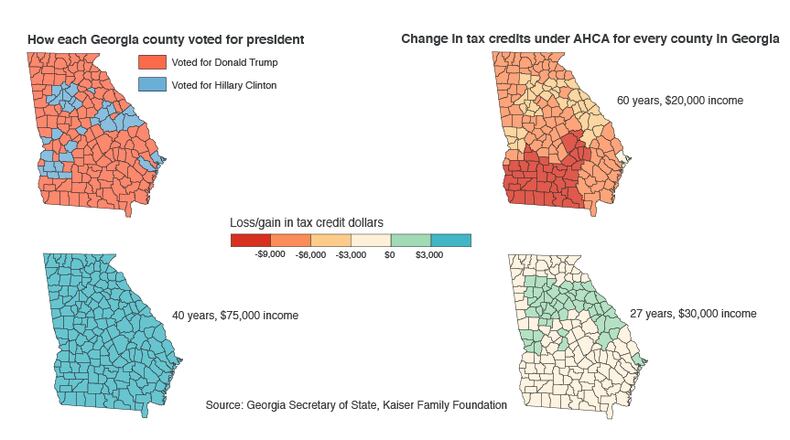One-size-fits-all was one of the chief criticisms of the Affordable Care Act, also known as Obamacare. It seems the alternative proposed by the Trump administration has taken the same route -- only this time, affecting the poorest and oldest Americans.
An AJC analysis of Kaiser Family Foundation data on the proposed American Health Care Act revealed that older Americans with the lowest incomes would be hit the hardest by the Republican replacement plan. The data shows that some people stand to lose as much as $10,560 in tax credits as compared to Obamacare. Many of these citizens voted for Donald Trump in the recent elections.
The following chart shows the difference in tax credits under Obamacare and the Republican alternative for a 60-year-old making $30,000 for every county in Georgia.
Obamacare considered income and the local insurance costs - which tend to be higher in Georgia’s lower income counties - to calculate tax credits. In contrast, the new plan proposes a flatter age-based scheme. The result? Americans with different incomes and varying insurance costs are squeezed into one category under the Republican plan.
Take, for instance, Clay County, which has a median income of $20,438 and Forsyth County, the richest county in Georgia with a median income of $88,816. Under the current healthcare system, a 60 year-old Clay County resident making $30,000 a year pays the same in premiums as a resident of Forsyth County of the same age and income.
However, it costs more to insure the Clay County resident than their counterpart in Forsyth, and so the Clay County resident receives a much higher subsidy under the current system. The replacement proposal would lump both of these counties under the same tax credit slab, which would leave the Clay County resident paying much higher premiums than Forsyth residents if the Republican plan goes into effect.
For some residents in high-cost counties, the loss of tax credits will mean either spending more to maintain the same amount of coverage, or simply losing insurance all together.
The Senate GOP released their draft healthcare plan Thursday, changing the way tax credits are calculated. The plan goes back to computing subsidies using age, income and geography of an individual, but limits subsidies to those with incomes up to 350 percent of poverty level ($42,000 for an individual). We are still awaiting data on how each county in Georgia will be affected by the Senate plan.
You can use the interactive below to find the difference between tax credits under Obamacare as well as the House Republican replacement plan.
About the Author
Keep Reading
The Latest
Featured





